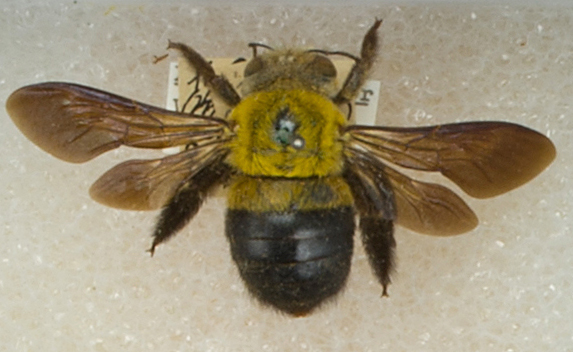 |
Xylocopa senior Vachal
Xylocopa senior
Vachal, 1899.
Holotype in
Paris (MNHN). Type locality: Tanzania. |

 |
|
Photographs © Iziko Museums of South Africa.
|
Distribution
|
Angola, Botswana, Congo, Democratic Republic of the Congo, Kenya,
Malawi, Namibia, South Africa, Tanzania, Zimbabwe. |
Biology
|
Carpenter bees bore tunnels into wood to construct a
nest, which they provision with a mixture of pollen and nectar
sculptured into an elongate shape. This acts as a food source for their
developing larvae. A number of partitions (each containing a single
larva) may be constructed within the tunnel, the partitions are made out
of chewed wood. Recorded visiting
flowers of:
Cassia didymobotrya, Cleome angustifolia, Combretum sp., Crotalaria
podocarpa, Crotalaria sp., Tephrosia oxygona. Nests in: Aloe littoralis,
Bequaertiodendron magalismontanum, Jacaranda sp., Uapaca kirkiana (Eardley
& Urban, 2010).
Parasitized by: Dinogamasus braunsi, Hyperechia consimilis,
Physocephala bimarginipennis (Eardley & Urban, 2010). |
References
|
Eardley, C.D. 1983.
A taxonomic revision of the genus
Xylocopa Latreille (Hymenoptera:
Anthophoridae) in southern Africa.
Entomology Memoir,
Department of Agriculture, Republic of South Africa 58: 67pp.
Eardley, C & Urban, R. 2010. Catalogue
of Afrotropical bees (Hymenoptera: Apoidea: Apiformes).
Zootaxa 2455: 1-548.
Michener, C.D. 2000. The Bees of the World. Johns Hopkins
University Press. 953 pp. |
Credits
|
Photographs of living specimens © Dave West (Randburg).
Photographs of specimens in SAMC © Iziko Museums of South Africa.
Map illustration © Simon van Noort (Iziko Museums of South Africa).
|
|